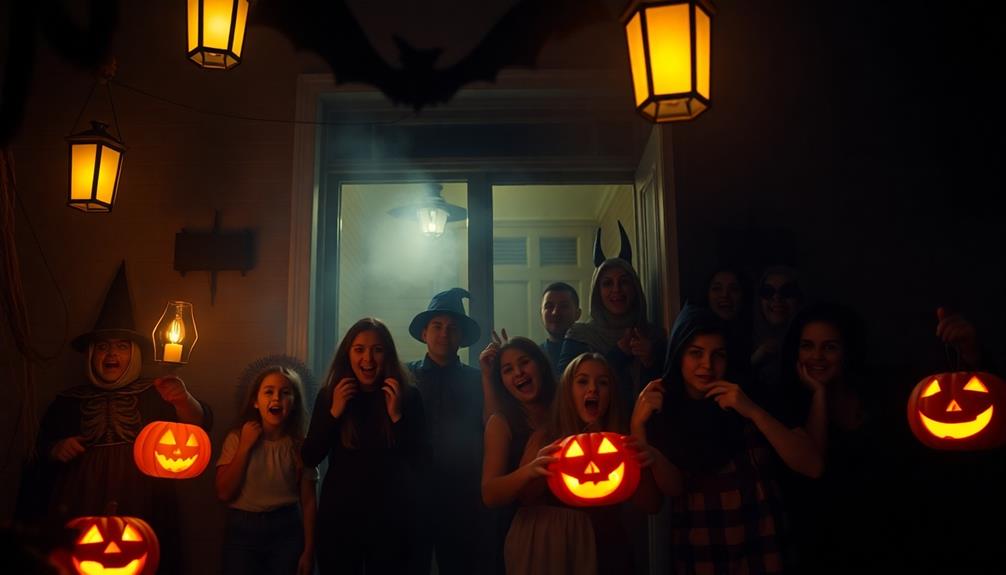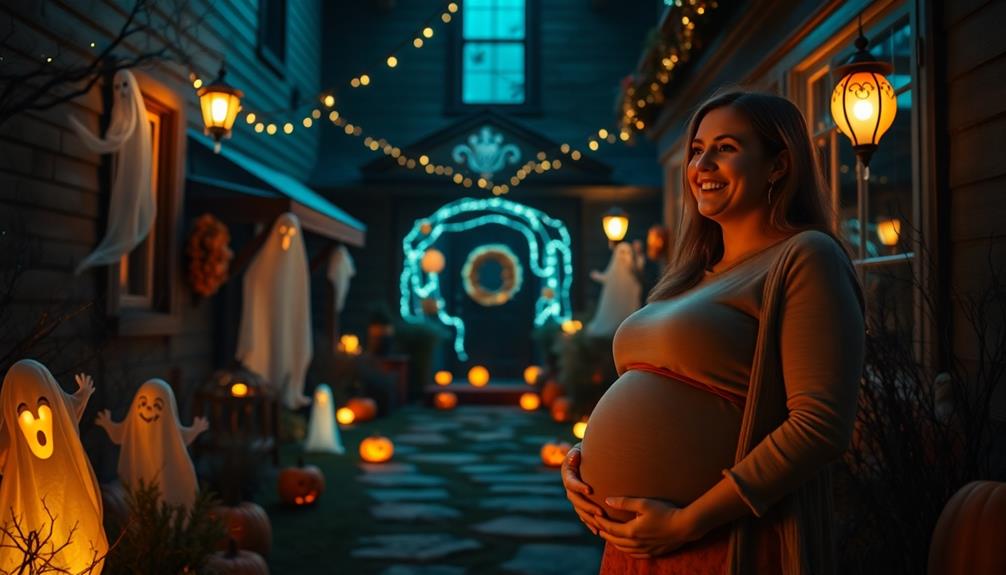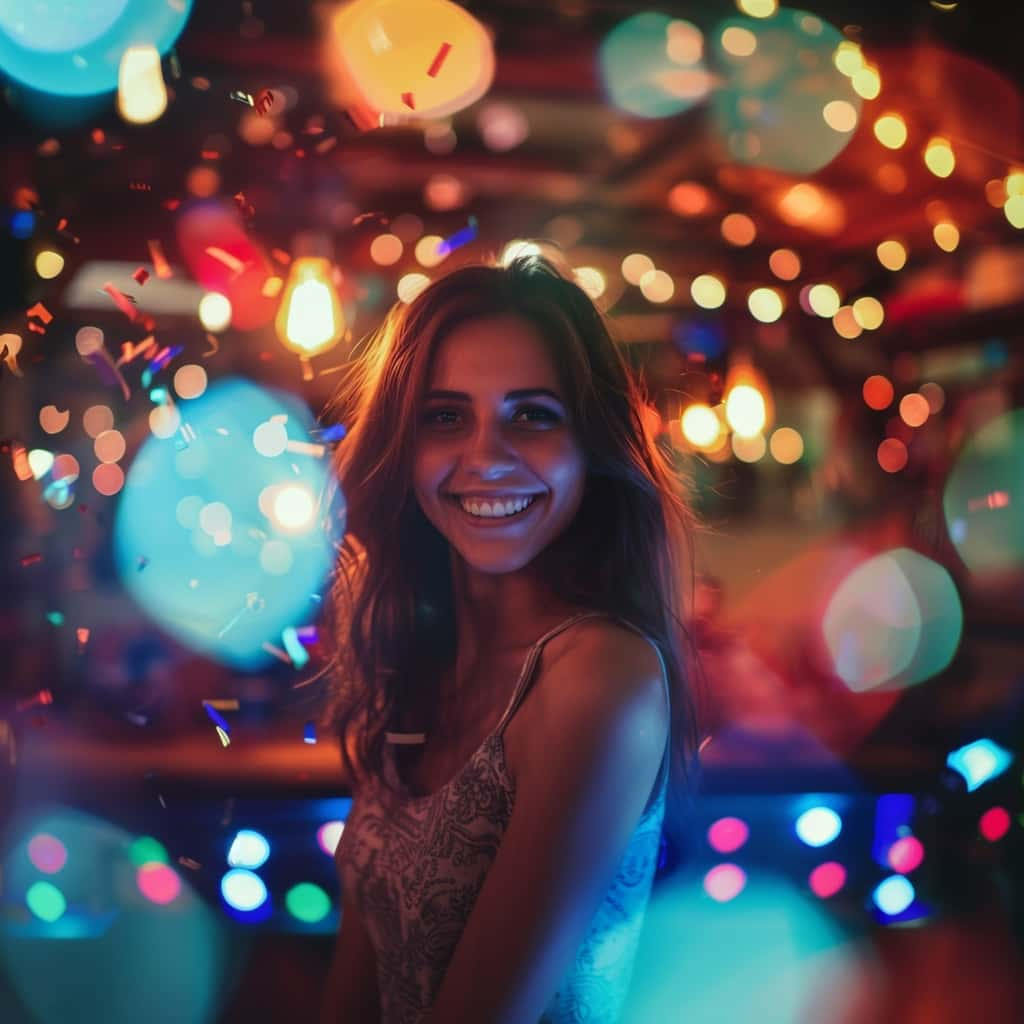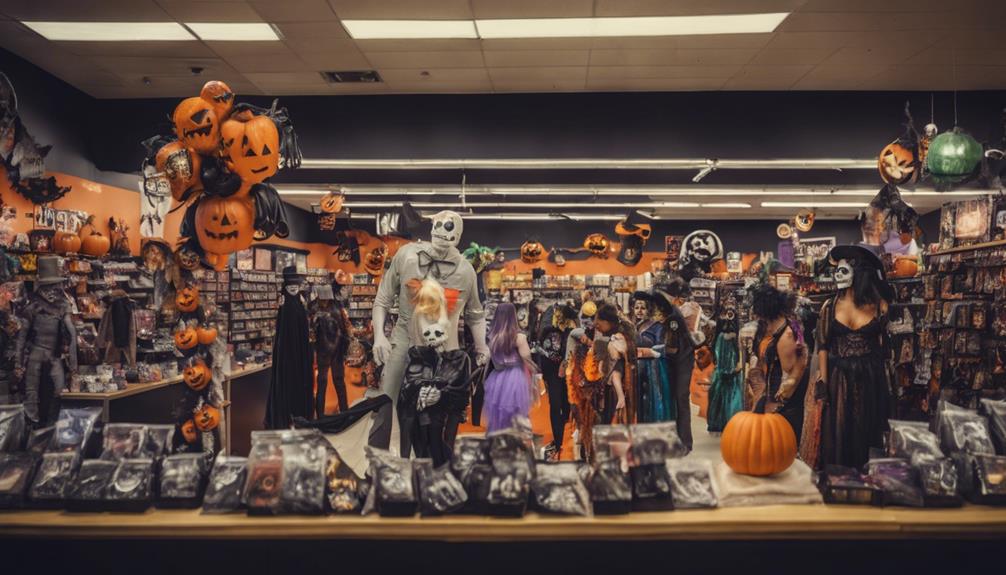You love Halloween Horror Nights because your brain thrives on the adrenaline rush of fear mixed with excitement. When you confront scary experiences, your amygdala activates, releasing stress hormones that heighten your senses and create a thrilling atmosphere. This adrenaline not only amplifies your excitement but also fosters deeper connections with friends through shared thrills. Engaging in these fear-inducing activities allows a safe exploration of your limits while creating memorable moments. As you continue to enjoy these experiences, you cultivate resilience against fear. The science behind this fascination reveals even more about why you savor these thrilling encounters.
Key Takeaways
- The thrill of fear activates the amygdala, releasing adrenaline and creating pleasurable experiences in controlled environments like Halloween Horror Nights.
- Shared scary experiences strengthen social bonds through the release of bonding hormones, fostering deeper connections among participants.
- Engaging in fear-inducing activities allows individuals to confront their limits safely, enhancing personal resilience and enjoyment over time.
- Cultural traditions surrounding Halloween celebrate fear, transforming it into a communal experience that connects people through shared rituals and folklore.
- Repeated exposure to fear leads to desensitization, enabling hardcore fans to appreciate the adrenaline rush and emotional catharsis during thrilling events.
Biological Responses to Fear

When you encounter a fearful situation, your body springs into action almost instantly. This rapid response kicks off with sensory input processed by your thalamus, which relays essential information to the amygdala. The amygdala plays a significant role in evaluating threats and initiating your body's response.
Once it identifies danger, it triggers the release of stress hormones like adrenaline and cortisol from the hypothalamus, which prepares you for a fight-or-flight response. Embracing burnout recovery can help you manage these intense physiological reactions effectively.
These biological responses to fear manifest in several physiological reactions. You'll notice an increased heart rate, heightened blood pressure, and sweating. These changes are all part of your autonomic nervous system's response to perceived threats. Notably, endorphins also flood your system during these moments, potentially leading to feelings of pleasure amidst fear, creating a complex emotional landscape where fear can feel like excitement.
Repeated exposure to fear can enhance your resilience. Your brain learns to navigate these experiences, gradually extinguishing the fear responses over time.
Psychological Appeal of Fear

Many people find themselves drawn to experiences that evoke fear, whether it's a haunted house or a scary movie. This attraction taps into the psychological appeal of fear. When you face frightening scenarios, your brain activates the amygdala, triggering a fear response that enhances emotional memory. This process helps you learn to avoid real dangers in the future.
The adrenaline rush that fear generates can actually heighten your excitement and alertness, making the experience pleasurable within a safe environment. You also gain a sense of control as you confront your fears without real consequences, allowing you to explore your limits.
Moreover, sharing these fear-inducing moments strengthens social bonds. The release of bonding hormones like oxytocin during scary experiences fosters connections with others, turning fear into a shared adventure.
Enjoyment of Scary Activities

Scary activities, like visiting haunted houses or watching horror films, tap into a unique thrill that keeps adrenaline junkies coming back for more. The enjoyment of fear-inducing activities isn't just about the scares; it's about the adrenaline rush that heightens excitement and alertness.
Engaging in thrilling experiences, such as portable camping toilets, allows you to confront your limits in a safe environment, giving you a sense of control and achievement.
When you engage in these thrilling activities with friends, you also strengthen social bonds. Shared experiences of fear amplify emotional responses, creating memorable connections with those around you. Plus, the endorphins released during these experiences can lead to feelings of euphoria, making the aftermath of fear surprisingly enjoyable.
Cultural events like Halloween enhance this enjoyment, providing communities with opportunities to engage in frightening experiences together. Whether you're screaming in a haunted house or laughing at a scary movie, the collective thrill fosters a sense of togetherness and excitement.
Cultural Significance of Fear
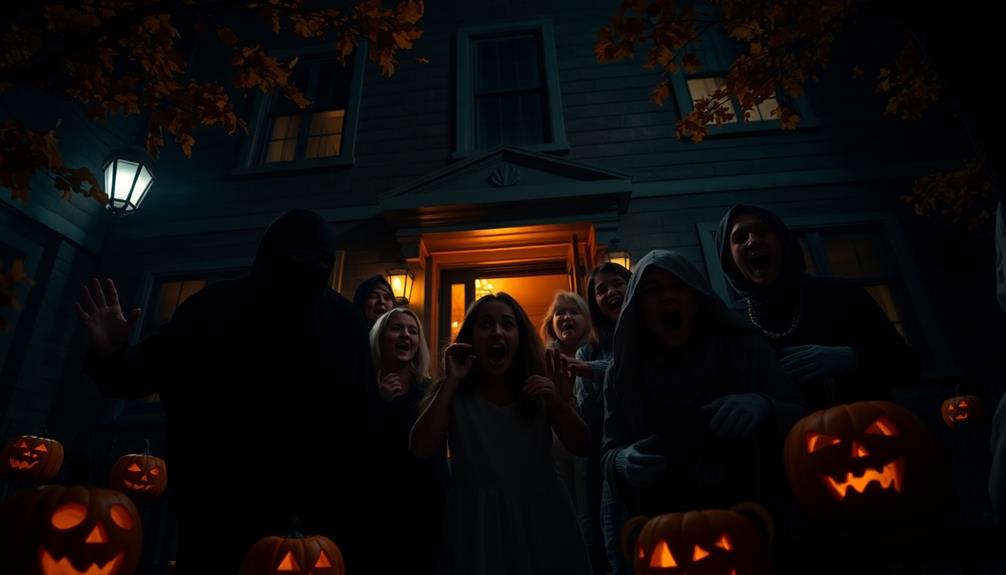
Fear plays an essential role in shaping cultural traditions, especially during events like Halloween. You'll see how local folklore and societal anxieties influence everything from haunted houses to ghost stories, creating a unique tapestry of fear-related celebrations.
For instance, the dynamics of relationships can be tested during shared experiences, much like couples maneuvering the challenges of travel.
Fear in Folklore
Throughout history, cultures have woven fear into the fabric of their folklore, shaping narratives that reflect societal anxieties and moral lessons. You'll find that fear serves as a central theme, often manifesting in cautionary tales warning against reckless behavior. These frightening experiences not only entertain but also educate, revealing the consequences of poor choices.
In a similar way to how people navigate the complexities of relationships, fear can also be a catalyst for reflection and personal growth, allowing individuals to confront their inner struggles and learn from past mistakes, as seen in overcoming past mistakes.
Many traditional stories employ supernatural elements like ghosts and monsters to explain the unknown. These narratives offer a sense of control over fear by providing resolution, allowing listeners to confront their anxieties within a safe context.
Halloween, rooted in ancient Celtic festivals like Samhain, transformed fear into a communal experience, celebrating the thin boundary between life and death through costumes and rituals.
Folklore often mirrors cultural fears, such as those surrounding witches and the supernatural, reflecting societal tensions regarding the "other." During fear-inducing events, storytelling becomes a communal act, helping to strengthen bonds as you and your community process collective anxieties together.
Halloween Traditions Explained
Halloween traditions, deeply rooted in ancient Celtic festivals, reflect a unique blend of cultural beliefs and practices that embrace fear as a powerful force. These customs serve not only to ward off evil spirits but also to celebrate the cycle of life and death.
As you explore Halloween, you'll discover several key elements that define its cultural significance:
- Haunted Houses: These attractions offer immersive experiences where you can engage with fear in a controlled environment, drawing on local folklore and mythology to heighten the thrill. Just as beaches provide opportunities for exploration and adventure, haunted houses create their own unique atmosphere of suspense and excitement, capturing the essence of fear.
- Community Bonding: Participating in scary activities fosters social connections, turning fear into a shared experience that enhances your enjoyment of the holiday. This bonding can be likened to the camaraderie felt during beach activities like wildlife watching, where people come together to appreciate and enjoy the natural world.
- Cultural Variations: Different regions celebrate Halloween in unique ways, reflecting local myths and historical events, showcasing various interpretations of fear that resonate with diverse audiences.
Ultimately, Halloween's allure lies in its ability to evoke fascination with the macabre while providing a space for communal celebration.
As you embrace these traditions, you'll find that fear isn't just something to dread; it's a means of connection and understanding in a world filled with uncertainties.
Social Dynamics of Fear
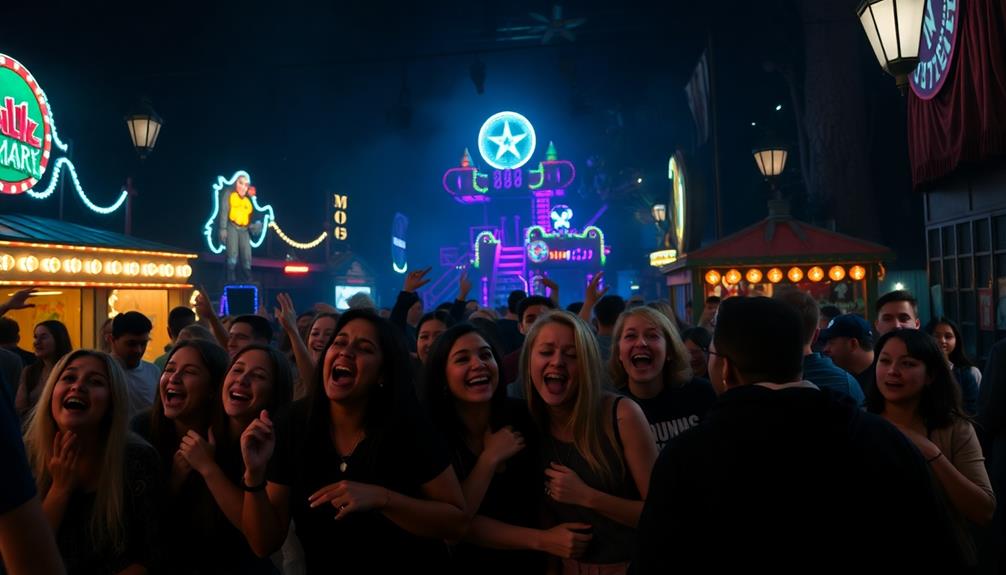
When you share a scary experience, like visiting a haunted house, it can strengthen your bonds with friends and family.
The thrill of facing fear together releases feel-good hormones, making those moments unforgettable.
This shared experience can be likened to the emotional connections formed during significant life events, where the importance of clear communication during a breakup can also enhance relationships.
You might find that laughter often follows, reinforcing your connections and creating lasting memories.
Shared Scary Experiences
Shared scary experiences, like those found at haunted houses or thrill rides, can greatly strengthen social bonds among participants. When you engage in these frightening activities, your body releases bonding hormones like serotonin and oxytocin, fostering feelings of closeness. This phenomenon can be likened to the way tea consumption promotes social connections in various cultures, as people often gather over a cup of tea to share experiences and stories.
Here's how it works:
- Memorable Moments: The adrenaline rush you feel, followed by laughter, creates lasting memories that reinforce your social ties.
- Amplified Reactions: Observing others' fear heightens your emotional response, transforming individual fear into a communal experience that solidifies group dynamics.
- Deeper Connections: After confronting your fears together, you're likely to engage in deeper conversations, processing your shared emotional experiences and excitement, which can lead to lasting friendships.
As you navigate these thrilling attractions, the collective thrill-seeking enhances feelings of camaraderie. The shared fear becomes a bond that links you to others, making the experience not just about the scares, but about the connections formed in the face of fear.
Bonding Through Fear
There's something uniquely powerful about facing fear together that transforms a simple outing into a memorable bonding experience. When you and your friends navigate the thrilling scares at Halloween Horror Nights, your shared adrenaline rush triggers the release of bonding hormones like serotonin and oxytocin.
These hormones foster a sense of closeness, making your connection with one another stronger. This shared experience not only enhances your enjoyment but can also be seen as a form of continuous learning and adaptation as you confront your fears together.
As you scream and laugh together, the fear-inducing environment creates camaraderie, reinforcing your social ties. Observing each other's reactions amplifies your emotional responses, turning the collective experience into something even more intense and enjoyable.
You might find that the thrill of a haunted house serves as an excellent conversation starter, allowing you to share your feelings and reactions, ultimately deepening your relationships.
In group settings, the enjoyment of fear is heightened. The shared excitement makes the scares feel more impactful than if you were alone.
Individual Differences in Fear
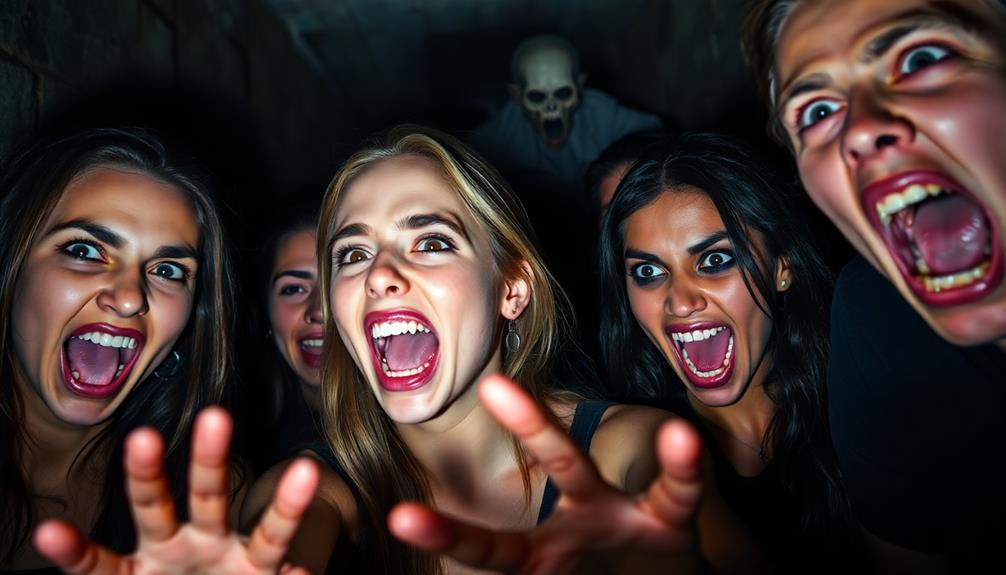
Fear is a deeply personal experience, shaped by individual preferences and sensitivities. You might find that your thrill-seeking friends love the adrenaline rush of haunted houses, while you prefer to steer clear of those frightening experiences.
These individual differences in fear considerably influence how you engage with horror events. Here are three key factors that contribute to this variation:
- Sensitivity to Fear Stimuli: Some people have heightened sensitivities, making horror experiences overwhelming and often triggering, especially for trauma survivors. This is similar to how certain individuals react to cold medications based on their unique health profiles.
- Personality Traits: Traits like openness to experience and sensation-seeking can dictate your enjoyment of fear-inducing activities. If you thrive on excitement, you're more likely to embrace the scares.
- Supportive Environments: Attending horror events with friends can help alleviate apprehension. The presence of others can create a buffer, making the experience more enjoyable for those who are typically more cautious.
Additionally, virtual reality offers a unique way to explore your limits with fear in a controlled environment, allowing you to confront your feelings safely.
Ultimately, understanding your individual differences in fear can help you navigate these thrilling experiences more effectively.
Desensitization Effects on Enjoyment

Experiencing fear repeatedly can actually change how you respond to it, leading to what's known as desensitization. When you immerse yourself in activities like haunted houses or horror films time and again, you start to notice that your initial jumpiness fades. This desensitization results in a reduced startle response, allowing you to enjoy the experience more fully.
As you engage with horror media frequently, you develop a tolerance for fear, enhancing your ability to find pleasure in traditionally scary situations. This increased comfort can bring a sense of control, enabling you to relish the thrill without feeling overwhelmed by anxiety.
Moreover, hardcore horror fans often experience a heightened emotional catharsis due to their desensitized responses, leading to a greater sense of satisfaction after confronting fear. The more you expose yourself to fear-inducing scenarios, the more you can appreciate the adrenaline rush, which can feel incredibly rewarding.
However, it's important to strike a balance—while desensitization can enhance enjoyment, excessive pursuit of fear may push you toward risky behaviors as you seek out heightened thrills.
Thrill-Seeking and Risk Assessment
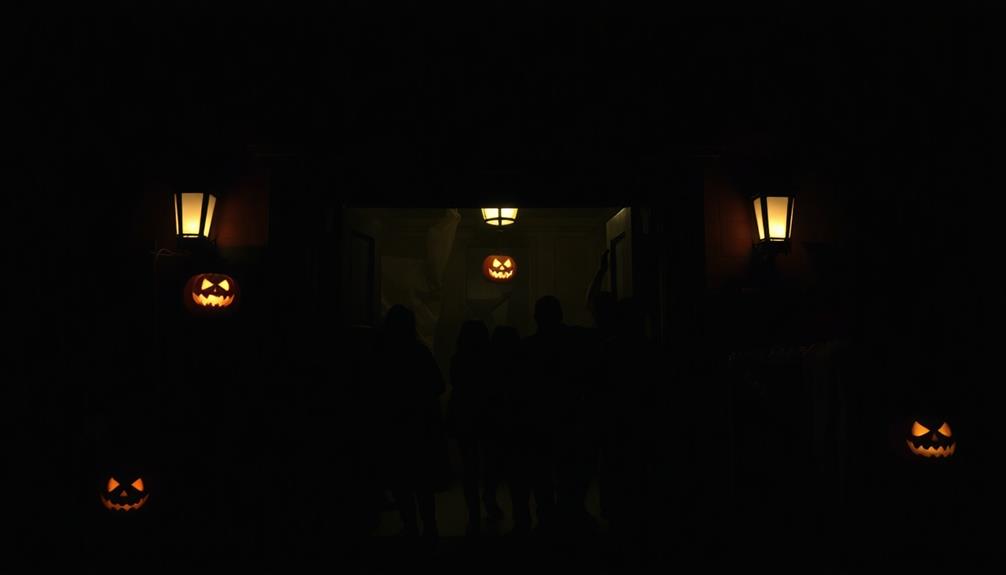
Engaging in thrill-seeking activities can ignite a powerful rush of adrenaline and dopamine, making fear feel exhilarating rather than threatening. This experience can also trigger the release of neurotransmitters that enhance mood, similar to the effects of aromatherapy on emotional well-being.
For many, the experience of fear becomes a thrilling challenge, and they actively seek it out. Here are three reasons why thrill-seeking individuals embrace fear:
- Dopamine Release: When you face fear, your brain activates reward pathways, releasing dopamine. This pleasurable rush can become addictive, driving you to seek more experiences that induce fear.
- Risk Tolerance: Those who enjoy thrill-seeking often have a higher tolerance for risk. Instead of seeing fear as a danger, you might view it as an exciting opportunity to push your boundaries.
- Social Experience: Thrill-seeking is often enhanced by sharing the experience with friends. Engaging in haunted houses or horror films together amplifies the fun and excitement, creating shared memories that deepen your enjoyment.
In this way, thrill-seeking transforms fear into a source of pleasure and excitement.
The Role of Adrenaline
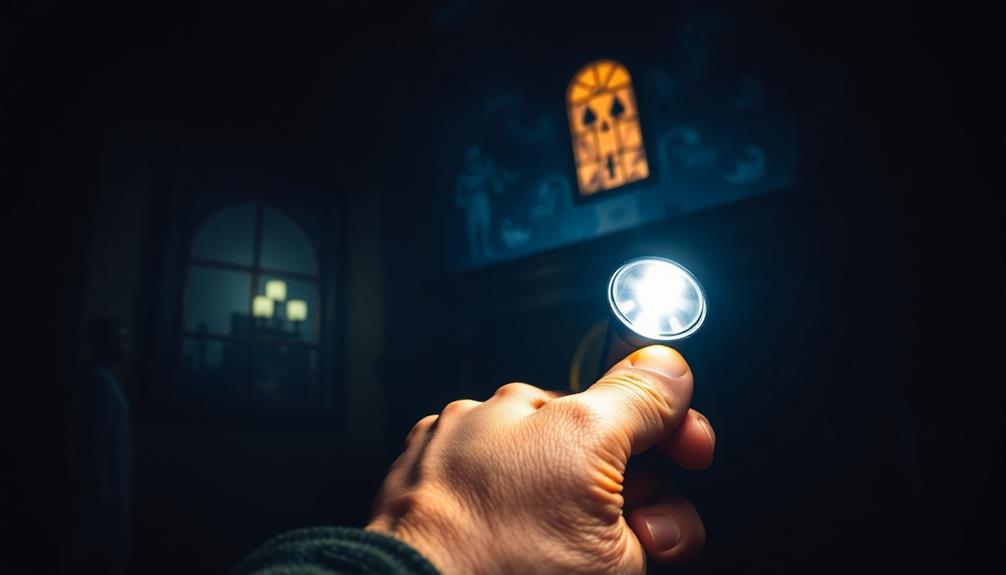
The thrill of seeking fear often connects with the body's natural response to danger, particularly through the release of adrenaline. When you step into the eerie atmosphere of Halloween Horror Nights, your body reacts instinctively. Adrenaline floods your system, increasing your heart rate and heightening your alertness. This rush creates an exhilarating sensation that many crave, drawing them back to haunted houses year after year.
Engaging in these fear-inducing experiences triggers your body's fight-or-flight response, amplifying the overall thrill. You might feel a mix of excitement and terror, a cocktail of emotions that keeps you on the edge.
Studies show that once the perceived threat dissipates, the combination of adrenaline and endorphins can lead to a euphoric high. It's not just about fear; it's about the rush that follows when you conquer it.
After facing the monsters in the dark, you often walk away with a newfound sense of accomplishment and boosted confidence. This reinforces the appeal of adrenaline-driven activities, making Halloween Horror Nights a sought-after experience for thrill-seekers like you.
Frequently Asked Questions
Why Do Some People Enjoy the Feeling of Fear?
You enjoy the feeling of fear because it triggers adrenaline and endorphins, making your heart race. In safe environments, it allows you to confront emotions, bond with others, and experience thrilling excitement that feels exhilarating.
Why Does Fear Excite People?
Fear excites you because it triggers adrenaline, creating a thrilling rush. You experience heightened senses and pleasure, exploring your limits safely. Plus, shared scares with others strengthen bonds, making the experience even more enjoyable.
Why Do People Like to Be Scared on Halloween?
You enjoy being scared on Halloween because it offers a thrilling escape from reality. The adrenaline rush, shared experiences with friends, and the chance to confront fears create excitement and strengthen bonds, making it unforgettable.
What Is the Science Behind Fear?
Fear triggers adrenaline and cortisol, activating your fight-or-flight response. This heightens sensations and enhances memory. In safe situations, facing fear builds resilience, while the brain's dual response to fear and pleasure can create euphoria afterward.
Conclusion
To sum up, your love for Halloween Horror Nights taps into a fascinating mix of biology and psychology. Did you know that around 60% of people enjoy scary experiences because they trigger excitement rather than just fear? This thrill-seeking behavior not only boosts your adrenaline but also fosters social connections with others who share your passion. So, embrace that rush! After all, it's not just about the scares; it's about the unforgettable memories you create along the way.
